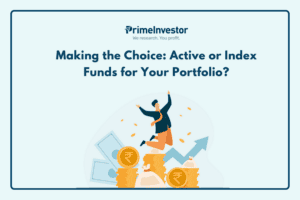Predicting stock market peaks has become a cautious endeavor for analysts and fund managers since early 2021 😊Those who called out the steep climb in the market from March 2020 lows to February/March 2021 had a lot to explain! A high index level is not something that deceives us easily. But a high PE (32 times consolidated trailing earnings as of April 2021) does!

But what if the high PE only steadily falls with a rapid increase in the earnings of the index companies? You have a case of falling PE and rising index. Sample the data below.
The trailing Nifty EPS was at a low of Rs 454 as of end-April 2021, only to move up sharply to Rs 777 by end-April 2022 and now at whopping Rs 1051. To put this in perspective – the EPS jumped 2.3 times between April 2021 and June 2024. The Nifty returned 1.66 times in the same period.
Those who assumed that the market was peaking in 2021 did not see such strong earnings growth coming, especially in a period when the market and economy were in the still-dealing-with-Covidphase.
The timing and strength of the recovery therefore remained uncertain during that period, causing the Nifty to vault when it saw the earnings traction coming by.
Now, at 23 times, the Nifty 50 PE cannot be outright called expensive. But before you are emboldened, know that the PE is now comfortably perched on high earnings (as opposed to low earnings in 2021). Whether the present pace of earnings growth will sustain will determine whether the current valuation is justified.
Analysts estimate PE of 22 times a year forward, not leaving much upside for the Nifty 50. And yet, in the last 3 months, we have still seen several sectors and individual stocks continue to deliver double digit returns.
So how do you plan your portfolio in this conundrum? Instead of trying to get a one-line response from analysts on whether the market is overvalued or undervalued, here are some pointers that you can apply to your stock and mutual fund portfolio.
Handling stock portfolios
Many of you have the question of whether you should exit the stock market at high valuations or stop investing entirely. These all-or-nothing calls have never worked when your objective is long-term wealth building. Building positions in stocks take time, patience and the blessing of market volatility. Exiting entirely will wipe off all the effort in one go. Instead, learn to tweak your portfolio in the following ways:
Exit poor quality stocks
Exit stocks with poor quality balance sheet or governance issues or those that you held on (due to your loss aversion) despite knowing they are bad. Also, stocks that you bought on hot tips on social media or based on their technical charts alone are best exited in such markets, without looking back.
Reduce exposure
Cut positions (not exit) in stocks that are moving on a tide, with a sector uptrend. A classic example would be defense, PSU, shipbuilding stocks and a good number of capital goods stocks that have run up very sharply. Unless their re-rating is accompanied by some significant changes in the company’s fundamentals or business prospects, know that valuations cannot be sustained. By reducing exposure, we mean that the overall allocation of these stocks/sectors should come down.
Book profits
It is not wrong to book profits (not fully sell) in fundamentally sound stocks if the prospects of the company look sound but near to-medium-term upside is priced in. This call is not easy for you to take. But we try to do it with Prime Stocks. With our ‘book profit’ call, we recommend removing at least a part of your profits in these markets, when valuations of good companies move sharply but are not accompanied by anything fundamentally different in the company’s strategy or business. Sometimes, it could be that near-term earnings also cannot keep pace with the elevated valuation.
But here, many of you make two mistakes: one, you outright exit the stock. This is especially bad when you had bought it at very low price or averaged it over time. Two, you do not redeploy the proceeds immediately in other opportunities (other Buy candidates that still exist). Unless your intention in stocks is to cut your equity position entirely (which you should not unless your specific goal is less than 3 years away), redeploying is mandatory.
Stop looking only at relative peer valuation
When the market is on a rising trend, there is a tendency to call a 70 PE stock cheaper than a 100 PE stock, without understanding the intrinsic potential in either. So, for a stock in your portfolio or the one you wish to buy, you may justify that it is a relatively lower valued stock. At such times, it is important not to lose sight of absolute valuation – that is, by how much is the stock trading more than its own average and whether the re-rating is gained from sector uptrend or there are other sound reasons.
Just to give you an example, we recently recommended a book profit call on a consumer discretionary company, even though its sector is in an uptrend. But we explained why its valuations were outlandish and it is hard to sustain. Just before this call, we had given a buy call on another consumer discretionary company. Such a valuation call was not only relative to peers but also its own historical valuation and prospects.
Learn to ride the winners with patience
If you have a long-term stock portfolio, you should learn to hold on to your winners (provided they are of good fundamental quality) as well. In fact, it is easier for you to do this in a stock portfolio than it is for a fund manager to implement.
To quote excerpts from an earlier article: Quite often, we see this “riding the winners” strategy playing out well in individual investors’ portfolio than in fund portfolios. This is either due to a concentrated approach or because individual investors allow the stocks to gain concentration with time, without trimming them. On the other hand, fund portfolios generally start with very low allocation or keep trimming their allocation in a stock beyond a certain point. Mutual funds are also constrained by the fact they have a cap on individual stock holding (read more about this in our book review on Nalanda Capital’s investment philosophy).
Many of these stocks may stop being high growth ones and instead become steady compounders, lending a solid foundation to your portfolio and reducing portfolio volatility. In our ‘hold’ calls and ‘book profits’ call, you necessarily must hold the whole or part of the stock.
Not every ‘buy call’ needs to be bought
At PrimeInvestor, while we continue to find opportunities for you, it is important for you to be aware of whether the stock is right for your portfolio. For example, if you are overloaded with finance stocks, adding one more can only up your portfolio risk.
You might want to do it by either reducing exposure in another finance stock or deciding not to add any. And sometimes, your overall equity allocation may be so high that you would need to decide whether to add more at all. Hence, it is important for you to weigh your own portfolio make-up before you add stocks. This will also ensure you do not spread yourselves too thin.
No SIPs in stocks
Building positions in stocks is important for long-term wealth building, no doubt. But you cannot do this by applying what you were taught for mutual funds – SIPs in stocks. We think SIPs in stocks is simply not done and we have elaborated it in this article: Should you do SIP in stocks?
If you are convinced about an investment opportunity, you should go ahead and deploy your sum in one shot. If at all you wish to average, it is best done by buying in 2-3 phases (after fixing the amount you want to deploy) when there are corrections. When a buy call is given, it is best to deploy at least 50% or more at that point (in a market high) than smaller amounts.
Sometimes, when the stock runs up too fast, you may never be able to average further, and you should be ok with that. If it is a blue-chip stock, such rallies are rare and therefore they give you time to deploy sums on market-driven corrections. SIPs in broad-market ETFs are fine, if you are using the direct equity route to steady wealth building.
Markets at a peak - Handling mutual fund portfolios
In reality, decision making in stocks can be a notch easier than mutual funds. The reason is that you do not have control over what your fund manager intends to do. But you need to be aware of the following very basic - but often forgotten facts - about mutual funds:
- Your fund manager is already doing the job of churning stocks in your MF portfolio – exiting the ones that appear frothy to more reasonably valued ones. This is true of every diversified fund.
- Your job in active management should largely be focused on asset allocation, market-cap mix, strategy mix and specifically taking calls on pruning themes/sector funds that have run up.
To us, rebalancing can be a simple and effective way to ensure you stick to the basics of investing and pruning portfolio in a disciplined manner. Let us elaborate how to use rebalancing effectively in the context of the above two points and also some general investing suggestions in this market.
- Looking at the fund’s price earnings valuation (PE) to decide whether to hold or exit can be a tricky affair since the fund manager is already doing something about it. Besides, if you held a mix of say growth-styled and value-styled funds, you may be tempted to reduce the growth styled ones and shift entirely to value styled funds – not knowing which strategy is set to outperform from here on.
- As part of your rebalancing exercise (bringing equity to original allocation) first look for ‘sell funds using our Portfolio Review Pro tool. In a market such as the present one, some of the funds with poor consistency will be at the top, giving you the impression that they have turned around. In reality, it will likely mean it is time to sell them as the stocks that never performed in their portfolio would be soaring now. Exiting now would be timely in making the most out of an otherwise poor performer.
- In a prolonged bull market, you would likely have piled on funds, picking top performers as and when you see them. Use such market highs to look at portfolio overlaps in the funds you hold (check the overlap tool here) and consolidate/reduce.
- After the above two, when doing a rebalancing, sector funds, small-cap funds and mid-cap funds – in that order - should be the funds to reduce if your equity allocation is deviated (5 percentage points or more) your original allocation. You can do this after the consolidation mentioned in the above point is done. When it comes to sector funds, the call is not just about pruning. It is about exiting on time. Do not try to apply the rule of riding your winners in a sector fund portfolio 😊 Higher exposure to such funds can not only up your portfolio risk but cause deeper pain later on. Just to lay out some examples, in themes such as PSU, infrastructure or realty, past experience teaches us that the entire gain can vanish in no time. The same is playing out now in cyclical sectors such as defense as well as PSU. It is best to take off profits or even fully close exposure in such opportunities. In other words – exit timing is crucial in such funds.
- Extending the above – avoid the temptation of increasing exposure to mid and small cap funds just because they have done well. We do not mean the existing allocation/SIPs you are running. We mean that you should avoid further additions, beyond the allocation level that is comfortable for your portfolio given your timeframe and risk.
- Redeployment is key to mutual fund investing as well. When rebalancing for asset allocation, shifting to debt or gold right away is necessary. When you are consolidating, investing right back (lumpsum is perfectly fine when you are moving within an asset class with similar risk profile) into an existing fund is equally important. This is irrespective of whether the fund will fall after such an investment. You can read more on when it is fine to invest through lumpsum here.
- Avoiding tax cannot be a goal. Rebalancing is portfolio hygiene. One cannot try to act too smart with it and get hurt later. Trying to bring in tax outflow as a factor in every decision may not always be a good idea. Sitting with funds with questionable corporate governance or high risk, simply because you will have taxes is myopic from a portfolio wealth building perspective. A very simple fact you have to tell yourself is that you do not pay taxes additionally. You pay it out of the profits you made. That is par for the course.
With your mutual funds, you might simply want to do a portfolio clean up – removing poor performers, booking out of thematic funds, pruning risk - without any asset allocation level rebalancing even in bull markets. This is perfectly ok, if you have a long-term portfolio. Yes, your portfolio will fall more in a correction but then, it will also gain more considering that you did not alter your asset allocation.
For portfolios of 10 years or more, outperformance is very well possible without rebalancing. This is common sense, considering that you allowed more of your money in equity, for it to compound. But for most investors, rebalancing reduces stress and a sense that you have indeed liquidated some profits that may evaporate in a correction.
Please note that none of the above points require you to stop investing. If you had stopped investments in every market peak, it is unlikely you would have timed the money in again in a correction. The time lost in the market cannot be entirely compensated for by timing the market.





16 thoughts on “Markets at a peak – what you should do now”
Thank you for the article. While my asset allocation hasn’t changed by more than 5%, I want to take advantage of the market peak to sell some of my underperforming funds. Additionally, I aim to reduce the number of funds in my portfolio and see this as an opportune moment to do so. However, I’m facing a dilemma: selling these funds would push my income into the range that incurs a 15% surcharge on income tax, resulting in a significant tax liability. Should I redeem only enough to avoid triggering the higher surcharge, or should I avoid any redemptions altogether?
You can do a gradual redemption esp. if you jump tax slabs. Vidya
Thanks for the article. Would it be possible to cover few additional sectoral funds currently with a buy call in PI. – Kotak Infra & UTI Auto (HOLD or Liquidate)
We had Kotak Manufacturing which is now a hold (not in Prime Funds) and Auto is still a buy. if there is an update we will definitely cover. thanks, Vidya
Excellent article and very timely!! Real stress reliever.
Hello Sir, Thanks! Vidya
Thanks for the timely post as always. Could not get the last but one paragraph on “for portfolios of 10 years + outperformance possible without rebalancing”. Appreciate if you can elaborate.
over 10 year periods or more, a portfolio that is not rebalanced (untouched) tends to do better than profit booking rebalancing etc because it would have enough time to recover from any falls. Even if it falls in the 9th or 10th year, the dent would be low, considering you never reduced equity for the entire period.The same cannot be said in shorter cycles. thanks, Vidya
Very good article. However it would be great to see a recommendation on how to manage Index funds. There is no fund manager so the profit booking is on investor. Also there are a few tricky funds like the Nifty 250 Index that does auto re balance every quarter and Nifty 50 Equal weight that does semi annual re balance. Please let us know your views on those as well.
Hello sir, You can build an index fund portfolio like any other portfolio. There is no active management except to check if tracking error is ok. There is a fund manager whose job is to mimic the index. So when you mimic the index, there is no need to take such calls. Your weight is similar on a daily basis to the index weight, mirroring whatever weight change is done there. On rebalancing, every index is rebalaced..the term rebalance in index is for change in constituents (new stocks in, old out)…in and out and consequent weight changes. THat happens irrespective of which index it is. Vidya
Thank you very much. So Index investors should focus on macro level things such as managing allocation to Equity (and within it various caps), Debt (Bonds, G-Sec) & Gold and re balance according to desired levels.
That’s right.
Hello Madam,
I forgot to check one other thing. What about Hybrid funds? I would assume they would manage asset allocation and profit booking? I would then only need to re balance asset allocation across Equity, Debt and Gold either by booking profit or channelling fresh money into under invested assets.
Please go by your own allocation to each fund. If you allocation to a hybrid aggressive fund has moved significantly, it would be because of equity being inflated. So, irrespective of the fact that the fund manager may be at 65:35 or 75:25, you can remove some.Youc an skip balanced advantage or equity savings category for such rebalancing. thanks Vidya
Great Clarity amongst the noise around ! Excellent as usual !
Thanks!
Comments are closed.